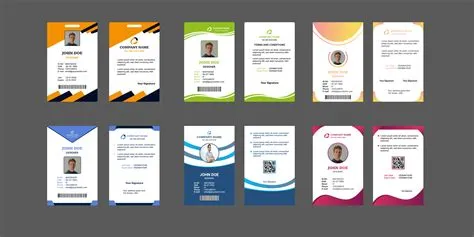Hey there, business owners and design enthusiasts! Let’s talk about something often overlooked but incredibly important: your business ID cards. They’re more than just pieces of plastic; they’re walking billboards, brand ambassadors, and a crucial part of your company’s identity. But in today’s world, we’re not just looking for stylish cards; we’re seeking innovation that blends aesthetics with sustainability. Ready to dive into the exciting world of modern ID card design?
We’ve all seen those generic, bland ID cards. Think lifeless plastic rectangles with barely legible text. They’re about as inspiring as watching paint dry, right? But your ID cards have the potential to be so much more. They can reflect your brand’s personality, communicate professionalism, and even enhance security. And now, more than ever, there’s a growing focus on minimizing their environmental impact.
Beyond the Basics: Embracing Modern Design
Forget the boring, predictable designs. Think outside the box (or, should we say, outside the plastic rectangle?). Today’s innovative ID card designs are all about creativity and personalization. We’re seeing a huge shift towards:
Custom Shapes and Sizes: Why stick to standard rectangles? Consider custom die-cuts that reflect your company’s logo or industry. Imagine a card shaped like a musical note for a music studio, or a house for a real estate agency!
Bold Typography and Color Palettes: Typography is a powerful tool. Choosing the right fonts conveys your brand’s personality. A playful script for a boutique? A sleek sans-serif for a tech startup? Your font choice speaks volumes. Similarly, strategically used color palettes can evoke specific emotions and enhance brand recognition.
Creative Layouts and Imagery: Use high-quality images, graphics, and even textures to add visual interest. Think about incorporating your brand’s story or mission into the design. A picture is worth a thousand words, after all!
Integration of Technology: We’re entering the age of smart ID cards. These aren’t just pretty faces; they often incorporate features like embedded chips for access control, NFC functionality for contactless payments or data sharing, or even QR codes linking to employee profiles or company information. Learn more about these possibilities by checking out our article on technology-integrated ID cards.
The Eco-Conscious Approach: Low-Impact ID Card Designs
But what about the planet? The environmental impact of traditional ID card production is significant. Fortunately, there’s a rising trend towards eco-friendly alternatives. Creating eco-friendly ID card materials and sustainable production methods are crucial for a business committed to ethical practice.
Here’s how businesses are making their ID cards more sustainable:
Recycled Materials: Opting for ID cards made from recycled PVC or other sustainable plastics drastically reduces the environmental footprint.
Biodegradable Materials: Explore plant-based alternatives like cornstarch-based plastics or even wood. While perhaps not as durable, they offer a fantastically lower carbon footprint and decompose safely and naturally.
Sustainable Printing Techniques: Soy-based inks and other environmentally-friendly printing methods minimize the use of harmful chemicals. Find out more about the possibilities here: eco-friendly printing techniques.
Minimalist Designs: Less is often more. Simple, clean designs require less material and ink, directly contributing to reduced waste and a lower environmental impact. This aligns perfectly with the ethos of low-impact ID card designs.
Digital ID Cards: The ultimate in sustainability? Digital ID cards! These eliminate the need for physical cards entirely, saving resources and reducing waste. Explore the possibilities further here.
Industry-Specific Designs: Tailoring to Your Needs
Your ID card should also reflect your industry. A healthcare provider’s ID card will naturally look different from that of a construction company, and rightly so. That’s where customization becomes key.
Think about the specific needs of your industry. Do you need to showcase certifications or specific security features? What information needs to be readily accessible? A well-designed card can even improve workflows. Check out our ideas on industry-specific ID card designs for inspiration!
Remember, your ID cards are a reflection of your brand. They should be professional, functional, and memorable. This involves carefully selecting appropriate materials, incorporating relevant information, and designing them in a manner appropriate for your company’s industry.
Personalization and Branding: Making it Your Own
Consider your ID card design as an extension of your branding strategy. Consistency is key. Your ID cards should align seamlessly with your logo, colors, and overall brand aesthetic. And don’t forget the power of personalization! Adding employee names and photos creates a sense of belonging and professionalism. For more ideas on this subject, see our resource on customization and personalization in ID card design.
Security and Functionality: Beyond the Looks
While aesthetics are important, the functionality and security of your ID cards are paramount. Consider features like:
Holograms and Watermarks: These deter counterfeiting and protect against fraud.
Barcodes and QR Codes: These can be used for quick access to employee information or other relevant data.
Magnetic Stripes and RFID Chips: These can be incorporated for access control and time tracking.
These features add a layer of security and improve efficiency, making your operations smoother and more secure. Learn more about the security aspects of ID card design on our website (link to relevant page).
The Future of ID Card Design
The world of ID card design is constantly evolving. We can expect to see even more innovative materials, technologies, and design trends in the future. As sustainability becomes increasingly important, we’ll likely see more eco-friendly options hitting the market. The use of augmented reality (AR) and virtual reality (VR) may also play a role in the future of identification and access control systems.
Conclusion:
Your business ID cards are more than just a formality; they’re a crucial part of your brand’s image and your operational efficiency. By embracing innovative designs, sustainable materials, and integrating technology, you can create ID cards that are not only visually appealing but also environmentally responsible and highly functional. Don’t settle for boring, generic cards. Let your creativity shine and make a statement that reflects your brand’s unique personality and commitment to a better future. Let your ID cards be a testament to your commitment to both style and substance!
Frequently Asked Questions
Q1: What are some of the most sustainable materials for ID cards?
A1: Several eco-friendly options exist, including recycled PVC, plant-based plastics (like those made from cornstarch), and even wood. The best choice will depend on your budget and desired level of durability.
Q2: How can I incorporate my company’s branding into my ID card design?
A2: Ensure consistency with your logo, colors, and overall brand aesthetic. Consider using your brand fonts and imagery to create a cohesive and memorable design.
Q3: What are the benefits of using technology-integrated ID cards?
A3: Technology integration offers enhanced security (access control, fraud prevention), efficiency improvements (contactless payments, data access), and a more streamlined workflow.
Q4: Are digital ID cards a viable alternative to physical cards?
A4: Yes, digital ID cards offer a highly sustainable and efficient alternative, eliminating the need for physical cards and minimizing environmental impact. However, security considerations and the availability of appropriate technology should be evaluated.
Q5: How much does it cost to design and produce custom ID cards?
A5: The cost varies greatly depending on the quantity, materials, design complexity, and features included (e.g., embedded chips, special finishes). Obtaining quotes from several vendors is recommended for accurate cost estimations.

